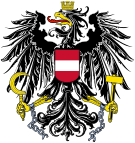| This article is part of a series on the |
| Politics of Austria |
|---|
 |
Parliamentary elections were held in Austria on 9 October 1994.[1] The Social Democratic Party of Austria (SPÖ) and Austrian People's Party (ÖVP) remained the largest parties, but both suffered losses to minor parties. The Freedom Party of Austria (FPÖ) improved to 22.5% and The Greens won 7.3%. The Liberal Forum, a liberal splinter from the FPÖ, won 6.0% and entered the National Council on its first attempt. The incumbent grand coalition of the SPÖ and ÖVP was renewed.[2]
Contesting parties
The table below lists parties represented in the 18th National Council.
| Name | Ideology | Leader | 1990 result | |||
|---|---|---|---|---|---|---|
| Votes (%) | Seats | |||||
| SPÖ | Social Democratic Party of Austria Sozialdemokratische Partei Österreichs |
Social democracy |  Franz Vranitzky |
42.8% | 80 / 183
| |
| ÖVP | Austrian People's Party Österreichische Volkspartei |
Christian democracy |  Erhard Busek |
32.1% | 60 / 183
| |
| FPÖ | Freedom Party of Austria Freiheitliche Partei Österreichs |
Right-wing populism Euroscepticism |
 Jörg Haider |
16.6% | 33 / 183
| |
| GRÜNE | The Greens Die Grünen |
Green politics |  Madeleine Petrovic |
4.8% | 10 / 183
| |
Results
 | |||||
|---|---|---|---|---|---|
| Party | Votes | % | Seats | +/– | |
| Social Democratic Party of Austria | 1,617,804 | 34.92 | 65 | –15 | |
| Austrian People's Party | 1,281,846 | 27.67 | 52 | –8 | |
| Freedom Party of Austria | 1,042,332 | 22.50 | 42 | +9 | |
| The Greens | 338,538 | 7.31 | 13 | +3 | |
| Liberal Forum | 276,580 | 5.97 | 11 | New | |
| No – Civic Action Group against the Sale of Austria | 41,492 | 0.90 | 0 | New | |
| Communist Party of Austria | 11,919 | 0.26 | 0 | 0 | |
| Christian Voters' Community | 9,051 | 0.20 | 0 | 0 | |
| United Greens Austria – List Adi Pinter | 5,776 | 0.12 | 0 | 0 | |
| Austrian Natural Law Party | 4,209 | 0.09 | 0 | New | |
| Citizen Greens Austria – Free Democrats | 2,504 | 0.05 | 0 | New | |
| The Best Party | 581 | 0.01 | 0 | New | |
| Fritz Georg | 482 | 0.01 | 0 | 0 | |
| Total | 4,633,114 | 100.00 | 183 | 0 | |
| Valid votes | 4,633,114 | 97.93 | |||
| Invalid/blank votes | 97,873 | 2.07 | |||
| Total votes | 4,730,987 | 100.00 | |||
| Registered voters/turnout | 5,774,000 | 81.94 | |||
| Source: Austrian Interior Ministry | |||||
Results by state
| State | SPÖ | ÖVP | FPÖ | GRÜNE | LIF | Others | |||
|---|---|---|---|---|---|---|---|---|---|
| 44.3 | 31.5 | 16.7 | 3.8 | 3.0 | 0.7 | ||||
| 39.5 | 16.4 | 33.5 | 5.9 | 3.8 | 1.0 | ||||
| 34.8 | 33.9 | 18.2 | 5.7 | 5.7 | 1.5 | ||||
| 34.5 | 28.9 | 22.5 | 7.6 | 4.7 | 1.8 | ||||
| 31.0 | 29.0 | 23.9 | 8.1 | 6.4 | 1.6 | ||||
| 36.6 | 27.5 | 23.4 | 6.2 | 4.9 | 1.4 | ||||
| 24.4 | 36.2 | 22.1 | 9.5 | 5.3 | 2.4 | ||||
| 20.9 | 37.8 | 23.6 | 9.0 | 6.5 | 2.3 | ||||
| 38.5 | 17.1 | 22.7 | 9.8 | 10.1 | 1.8 | ||||
| 34.9 | 27.7 | 22.5 | 7.3 | 6.0 | 1.6 | ||||
| Source: Institute for Social Research and Consulting (SORA)[3] | |||||||||
References
- ^ Dieter Nohlen & Philip Stöver (2010) Elections in Europe: A data handbook, p196 ISBN 978-3-8329-5609-7
- ^ Nohlen & Stöver, p216
- ^ "National election results Austria 1919 - 2017 (OA edition)", Institute for Social Research and Consulting (SORA) (in German), Austrian Social Science Data Archive (AUSSDA), 2019-07-24, doi:10.11587/EQUDAL











You must be logged in to post a comment.